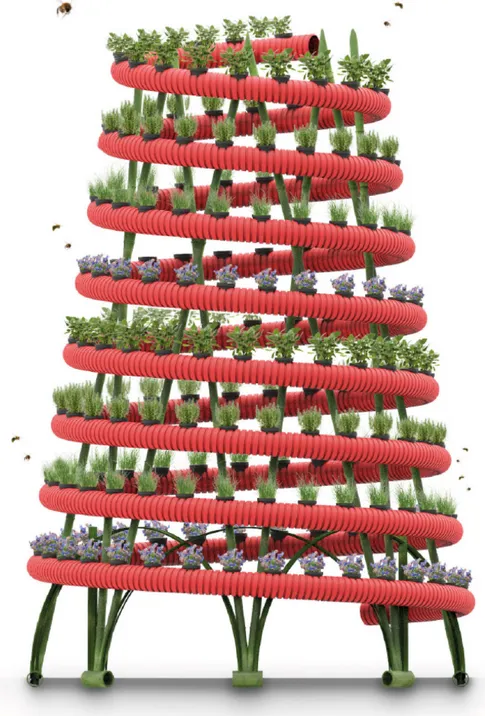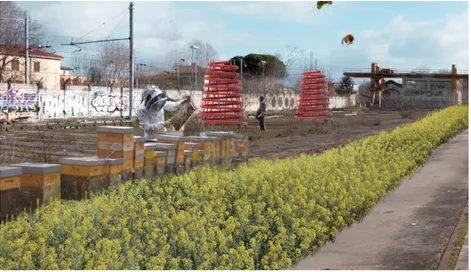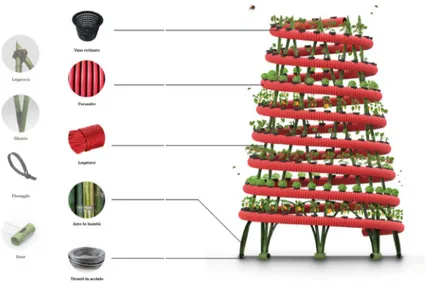BE[E] THE CREATIVE FOOD OF SOCIAL
INNOVATION
Raffaella Fagnoni
Three-fourths of the world’s flowering plants and about 35% of food crops depend on pollinators to reproduce: more than 3,500 species of native bees help humanity to increase farming yields. However, due to climate change and pesticides, pos-sible extinction scenarios for these insects have been reported. How can design address this problem? What can design do for bees? A bachelor final research project (“There is no plan bee”)1 focuses on the city’s abandoned spaces and the actions of creative citizens. On the one hand, the possibility to reuse abandoned places practising sustainable solutions. On the other hand, the chance for citizens and cities to activate bottom-up design practices and social innovation, facilitat-ing a kind of circular city. Civic participation extends to the makfacilitat-ing of new urban communities, through simple self-produced installations, aiming to cultivate new visions and to influence creative food cycles. The paper aims to new models of knowledge production, addressing social, environmental and economic issues linked with food culture. It also deals with designing for common goods as a need for our next future.
INTERSPECIES DESIGN2
One-third of our food depends on insect pollination: only in Europe, we can count over 4,000 types of vegetables. Unfortunately, bees are in decline, threatened by pesticides, habitat loss, monocultures, pests, diseases, and climate change, as documented by the specialist or international associations, such as Greenpeace. Development focused only on human needs has caused damage to the system, thus today Paola Antonelli talks about 'interspecies design', that means designing observing other species, imitating nature. She suggests a restorative design that not only reduces its footprint but regenerates the current condition, recognises the aberrations of the Anthropocene, and goes beyond. She seeks interspecies collaboration, shared activities and co-creation, mixture and circularity. It seeks empathy and the awareness that we are part of nature but not the owners. (Anton-elli 2019) Also Kate Raworth, economist, proposes a vision of the regenerative and circular project to overcome social degradation that must go hand in hand with the environmental crisis. Too often the world of design has been generically criti-cised for not being able to provide adequate answers to the ecological issues. The great challenge, as Paolo Deganello defines it in his book Political Design (2019), represents the opportunity to respond to the environmental crisis by designing for the common good.
THE COMMON GOOD IS DESIRABLE
Even if the world is not yet ready to consider Design as a common good, we must aim for it. The notion of commons had its origins in the medieval peasant practic-es, and today, by commons, we can mean “social systems formed by three basic interconnected elements”: a commonwealth; a community of commoners; the praxis of communing. (De Angelis 2019, p. 124) More and more often the community is wondering about the contribution of design to the common good, that means […] benefits society as a whole in contrast to the private goods of individuals and sections of society (Stanford Encyclopaedias of Philosophy). Design as a discipline had always worked catering the private good. Recently, by necessity, the 17 UN Sustainable Development Goals considered Design as common good as a priority to co-create and co-design among governments, industries, academia, and civic associations to achieve socially desirable innovations.
NO MORE ALARMING NARRATIVE.
WE NEED RESPONSIBILITY AND CIVIC AWARENESS
"If we look at the bigger picture in its entirety, the first thing that springs to mind is that there's nothing in this model that deserves to be sustained." (Morton 2019) The term "sustain" necessarily implies something to maintain, without altering a previous situation, which is why producers like it too. Many people today under-stand sustainability as the effort to maintain the system with which we have been inhabited until now. If we put together a business model with ethical issues without a real change in the production system, we get greenwashing solutions in the best cases or, worse, trivial marketing operations.
The emergentist and alarming narrative frequently used to communicate the envi-ronmental crisis, does not help the purpose. To frighten individuals does not help to change attitudes; on the contrary, it stimulates conservative attitudes, causes closure and rejection. So, as Morton suggests, we must focus not so much on guilt, but on a sense of responsibility.
One of the most important aspects of progress is that it does not concern the ac-cumulation of objects, technology, and knowledge: it concerns awareness. (Mul-gan 2018) We have experienced that economic growth does not automatically turn into social or human progress. It does not always produce what we need. Thus, thinking in terms of growth as we have done in the past does not bring great bene-fits. Awareness is the key to identifying the real needs of people and the planet and should guide innovations and policies.
FUTURES THAT HAVE A FUTURE
As Mulgan claims in his “The Imaginary Crisis" (2020) we are experiencing an un-precedented crisis of imagination. We are able to imagine apocalyptic scenarios or great technological developments, but we are unable to develop a better society, with healthy social balances and cooperation to better living. We know how to do business, but we don't know how to do society. To be good designers, first of all, we need to be good citizens. Being civic-minded and acquiring consciousness is the first step towards making the right choices. We need to tidy up the world we live in, for the benefit of all, but to do it, rather than great ideas, we need the funda-mentals of civic consciousness. If we want to pursue what Escobar calls “futures that have a future” (Escobar 2018) we need more civic consciousness. We have to use design as an enzyme transforming our way of living, educating, practising. By spreading good practices some attitudes can be taught or trained, as, for instance,
taking care of relationships with others, following the key themes of social innova-tion. (Mulgan 2018) But to change we need to experiment through initiatives that strengthen the civic fabric, fostering horizontal relationships, able to promote and implement circular economy principles, and resulting in a resilient system that fa-cilitates new kinds of social, environmental, technological, and economic activi-ties.
MORE REUSE LESS RECYCLE
The risk of recycling is the legitimacy to produce anything. The importance of re-use on recycling is another nuance of concept not always grasped by designers. The use and reuse of already built objects or products take on, in addition to a pragmatic and optimisation value, the power of restoring life to something expired and unused. Above all, reusing means proposing a sustainable alternative to the rapid obsolescence of objects, goods, and artefacts without history and identity. The reuse creates economic and even social sense only if we can extend it to mass consumption and make it a widespread behaviour that reduces the production and consumption of the new and contributes to saving the planet's resources.
THERE IS NO PLAN BEE
"There is no plan bee". This is why today we need to imagine new scenarios, design-ing them by proposdesign-ing visions, havdesign-ing the courage to experiment them to recover what we risk losing forever. "There is no plan bee" is the title of Giovanni Foppiani's graduation thesis, at ISIA in Florence, discussed in February 2020. It is one of the answers that our students seek to advance, stimulated to work as active citizens and to propose an ecological turn. The name of the project recalls the banners dis-played by demonstrators during the first global climate strike called by Greta Thun-berg, in March 2019. There is a strong link between the project and this historic mo-ment. In the Anthropocene era, it is no longer possible to ignore the environmental crisis to which we have contributed so much. The environmental deterioration is the outcome of the anthropocentric vision that has so far steered the choices with disastrous influences on the planet. The consequences of these choices also fall on bees, which risk endangering the entire food system, since they are the main pollinators and breeding agents of plants.
The choice to link abandoned spaces and the conception of a new habitat for bees is not just an urban reuse operation. It is an opportunity to see abandoned spaces as a rich source of spontaneous biodiversity. Green infrastructures represent the
direct consequence of this kind of reflection on brownfields, where the urgency to find new alternatives for food production in cities also converges. Agriculture, food production and consumption represent one of the most impacting sectors on which to speculate since they are one of the main causes of climate change and lead to deforestation, polluting waste, desertification and reduced fertility, which are burdensome both for the environment and for human health. The project draws attention to the environmental crisis, and in particular to the extinction of bees, highlighting their fundamental role in the ecosystem.
The project lies in the abandoned space of the Ex Officine Grandi Riparazioni di Firenze, a former railway area that has been abandoned for many years, with a sur-face area of 92,000 m2 and represents one of the greenest areas in Florence, due to its proximity to the Visarno and Cascine parks but at the same time very close to the city. The physical degradation over the years has also intensified the social degradation.
The actions foreseen by the project are:
– a series of plantings and cultivations on the ground, to regenerate the soil and attract bees, allowing the adaptation of the space to be used as - a place for agriculture and food production;
– the insertion of easily self-producing structures for vertical farming with hydroponics;
– a documentation and training centre on hydroponic, cultivation, bees and beekeeping.
The distinction between ground cultivation and hydroponics helps us to identify the most suitable solution for different crops. After a comparison with experts in the field, the Nutrient Film Technique (NFT) was chosen, which consists of run-ning water on a slightly inclined tray where the plants can absorb what they need. This process ensures a constant supply of nutrients and water to the roots. This process is similar to drip irrigation. Hydroponic agriculture has assumed central importance in recent years both because of the urgency to find alternative solu-tions for food production by optimising water resources and because it allows the cultivation of plants even where the soil does not allow it.
The structures provided for vertical farming are intended to house crops of two types:
– nectariferous, located in strategic locations to attract bees to the abandoned plant where they will find a highly developed biodiversity (basil, chives, rose-mary, sage and borage, aromatic plants that are very attractive to bees); – fruit vegetables, which, in addition to being pollinated by bees, also represent an important solution for the set-up of the new city Zero Km. The main crops planned are tomatoes, peppers, cucumbers and all green leafy vegetables (chard, mustard, salads, lettuce, rocket) to be placed with the caution of the weight of the fruit and to prevent the broad-leaved ones from shading those below, obstructing their growth.
In this way, possible good practices of social innovation become practicable; an extended civic participation leads to the creation of new urban communities, with the aim to cultivate new visions affecting creative food cycles. The element de-signed for cultivating can be easily made by bamboo, economic or waste materials, with low environmental impact. The design solution experimented particular kinds of bamboo simple joints, combining easy to find materials.
If today’s role of design is more and more concerned about how to scale-up solu-tions in everyday life i.e. services, social innovasolu-tions or product-service systems that bring about social change, there is an immediate need of understanding how co-designed solutions can firstly, be sustainable and secondly, how these solu-tions can be replicable in other contexts on various scales. (Ballantyne-Brodie, Telalbasic 2017)
FOOD CULTURE, SUSTAINABILITY, AND SOCIAL INNOVATION
The idea of food is linked to that of nature, but the connection is ambiguous. The core values of the food system are not defined in terms of naturalness but as the outcome and representation of cultural processes that involve transformation, do-mestication and reinterpretation of nature. Hippocrates with the ancient doctors and philosophers defined food as "Res non-naturalis" including it among the life fac-tors that do not belong to the natural but to the artificial order of things. Therefore, to the culture that humanity itself creates and preserves. (Montanari 2004, p. XI) Projects like "There is no plan bee" (and many others) can help bring food culture— as it is close to people—back to sustainability through social innovation practices. Involving people in all the stages of the process, from the production of vertical farming facilities to the care and cultivation, from harvesting to consumption, is an opportunity to experience and spread the values linked to food culture.
and taking care of food, appreciating values.
In the preparation phase, people practice with food and follow rituals.
In the consume phase, people live the convivial moment, linked to the main rituals and important gestures of our traditions.
In the disposal phase, people apply knowledge and practices that intersect tradi-tion and innovatradi-tion.
BE[e] THE CREATIVE FOOD OF SOCIAL INNOVATION
From design for the common good to social innovation, food culture and rituals linked to food cycles mark important occasions of knowledge at every stage. They can be an opportunity to nurture processes useful for the development of civic aware-ness, to foster social innovation, to be the change that our reality demands of us. Gardening and preparing food from what is growing in the garden have been in-tegral parts of religious and educational practice in many spiritual traditions, in many different times, from Christianity to Buddhism. Cultivating and cooking are examples of cyclical work. Work that has to be done over and over again, work that does not leave any lasting traces. You cook your food that then is eaten. You plant, manage the field, harvest, and then plant again. These rituals help us to recognise the natural order of growth and decay, of birth and death and thus make us aware of how we are all embedded in the cycles of nature. Food Cycles are one of the ear-liest and most important ecological concepts. From the beginning of the science of ecology, ecologists recognised that the food cycles are all interconnected; most species feed on several other species, as we do. (Capra 1999, p.19)
In a typical food cycle, the plants are eaten by animals, which are then eaten by other animals, and thus the plant’s nutrients are passed on through the food web, while energy is dissipated as heat through respiration and as waste through ex-cretion. The wastes are decomposed by insects and bacteria, which break them down into basic nutrients to be taken up once more by plants. (Capra 1999, p. 22) By experimenting these food cycles people become aware of how we are part of the web of life. The survival of humanity will depend on our ability to understand the principles of ecology and live accordingly. (Capra 1999, p. 52).
ACKNOWLEDGMENTS
This contribution is addressed to Giovanni and to all the young people who, like him, are working to have their future, using the design tools to change things. The innovators remain optimistic as Martin Luther King used to say, with the confidence to plant an apple tree today, even if there is the risk that the world will collapse tomorrow.
FOOTNOTES
1 Some parts of this paper are the result of thoughts shared with Giovanni Foppiani during the nine months of his bachelor final research thesis at ISIA Firenze, discussed on February 2020 session (ay. 2018–19).
2 The concept of interspecies design is treated by Paola Antonelli on several occasions, lately in the exhibition Broken nature.
BIBLIOGRAPHY
Antonelli P., Tanir A. (2019) Broken Nature, XXXII Triennale di Milano. Milano, Electa.
Ballantyne-Brodie E., Telalbasic I. (2017) “Designing local food systems in everyday life through service design strategies”. In: The Design Journal 20:sup1, S3079–S3095.
Bistagnino L. (2014) MicroMACRO. Micro relazioni come rete vitale del sistema economico e produttivo. Milano, Edizioni Ambiente.
Capra F. (1999) “Turn, turn, turn: understanding nature cycles”, Liverpool Schumacher Lectures. In: Capra, F. ed. (2005) Ecoalfabeto, L’orto dei bambini. Viterbo, Stampa alternativa.
De Angelis, M. (2019) “Commons”. In: Kothari A. et al. ed (2019) Pluriverse: A Post-Development Dictionary. New Delhi, Tulika Books, pp. 124–127.
Deganello P. (2019) Design Politico. Milano, Altraeconomia.
Escobar P. (2018) Designs for the Pluriverse: Radical Interdependence, Autonomy, and the Making of Worlds. New Ecologies for the Twenty-First Century. Durham, Duke University Press.
Manzini E. (2015) “Making things happen: Social innovation and design”. In: Design Issues 30(1), pp. 57-–66. Morton T. (2019) Cosa sosteniamo? Pensare la natura al tempo della catastrofe. Perugia, Aboca Edizioni. Montanari M. (2004) Il cibo come cultura. Bari, Laterza.
Mulgan G. (2018) “L’intelligenza collettiva ci farà riflettere”. In: Morning Future, 5/9/2018. Mulgan G. (2019) Social Innovation: how societies find the power to change. Policy Press.
Mulgan G. (2020) The Imaginary Crisis (and how we might quicken social and public imagination). UCL, Demos Helsinki and Untitled. Available online at: https://www.demoshelsinki.fi/wp-content/up-loads/2020/04/the-imaginary-crisis-web.pdf.
Raworth K. (2017) Doughnut Economics: Seven Ways to Think Like a 21st-Century Economist. UK, Penguin Random.


